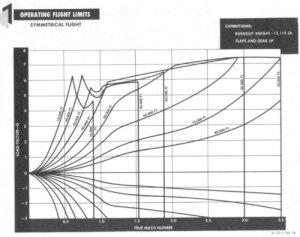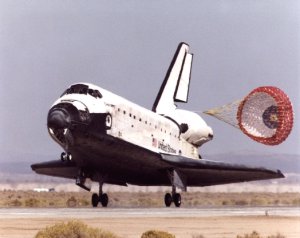X-15 Science and Engineering
Achievements

|

|
X-15 flight envelope, charted from
-3 G to +8 G at speeds up to Mach 3.5
|
A well-known benefactor of X-15 technology,
Space Shuttle orbiter Discovery returns from orbit
to NASA Dryden at Edwards AFB
|
The X-15 research program was the last major investigation of hypersonic
and high altitude flight by a manned aircraft. Four decades later, engineers
and researchers still use data gathered by the X-15 as a state-of-the-art
reference for hypersonic aerodynamics.
The X-15 pioneered research leading directly to manned space flight.
It explored
- New territory in aerodynamics, including validation of computational
models for hypersonic research and design
- Hypersonic stability and control
- Severe aerodynamic heating and flight at record-high dynamic pressures
- Rocket propulsion, including the first man-rated throttleable rocket
engine
- Novel systems engineering throughout its airframe
- Pilot life support systems for hypersonic flight and space flight,
including the first true space suit
- Control systems and human interface technology for hypersonic flight
and space flight
- Support systems, procedures, and organizations. Many were
essential for safety of flight. The High Range was a major project to provide
tracking and telemetry reception in real time during X-15 flights.
- Other high-altitude scientific research, carrying instruments to
the edge of space
Over time this web site will add separate pages with more detailed descriptions
of these areas, with links to those pages to be added in the list above.
A few additional links will lead to more detailed examples of particular
technical challenges and innovations. The first such examples probably will
be...
- Windshields: How to handle everything from frost to cracking from heat
stress and ablative fogging
- Nose landing gear: How to handle complex requirements with a simple
system and keep it from popping open at Mach 4
- Main landing gear: "Hitting the skids" and why control inputs at touchdown
should be the opposite of what's appropriate in "normal" planes
Photo credits and web cross-references for this page:
The X-15 flight envelope diagram is from the North American Aviation
X-15 Flight Manual. This is one of a series defining load limits for several
airframe configurations. This one is for gear up, flaps up, and rocket fuel
exhausted -- a configuration that applies to atmospheric reentry at the end
of an altitude mission.
The Space Shuttle landing is NASA photo EC00-0311-3. This was the end of
mission STS-92, on October 24, 2000.
Send questions and comments on the SierraFoot X-15 web pages to
Paul Raveling.
Return to X-15
home page SierraFoot
site home page



